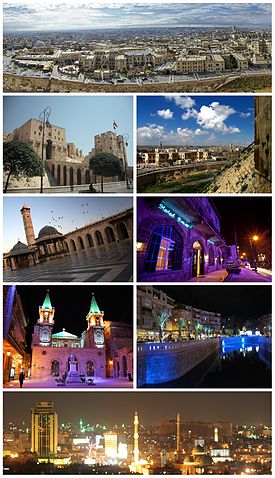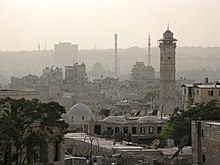Aleppo
Aleppo
ﺣَﻠَﺐ | |
|---|---|
City | |
 Ancient City of Aleppo Aleppo Citadel • The entrance to al-Madina Souq Great Mosque of Aleppo • Baron Hotel Saint Elijah Cathedral • Queiq River Panorama of Aleppo at night | |
 Seal | |
| Nickname(s): | |
 Aleppo Location of Aleppo in Syria | |
| Coordinates: 36°13′N 37°10′E / 36.217°N 37.167°E | |
| Country | |
| Governorate | Aleppo Governorate |
| District | Mount Simeon (Jabal Semaan) |
| Subdistrict | Mount Simeon (Jabal Semaan) |
| First settled | 5000 BC |
| First city council | 1868 |
| Government | |
| • Governor | Ahmad Hussein Diyab |
| • Mayor | Maad al-Madlaji |
| Area | |
| • Total | 190 km2 (70 sq mi) |
| Elevation | 379 m (1,243 ft) |
| Population (2016) | |
| • Total | 1,800,000 |
| Demonyms | Arabic: حلبي Ḥalabi English: Aleppine[2] |
| Time zone | UTC+2 (EET) |
| • Summer (DST) | UTC+3 (EEST) |
| Area code(s) | Country code: 963 City code: 21 |
| Geocode | C1007 |
| Climate | BSk |
| Sources: Aleppo city area[3] Sources: City population[4][5][6] | |
| Official name | Ancient City of Aleppo |
| Type | Cultural |
| Criteria | iii, iv |
| Designated | 1986 (10th session) |
| Reference no. | 21 |
| State Party | Syria |
| Region | Arab States |
Aleppo (/əˈlɛpoʊ/ ə-LEH-poh; Arabic: ﺣَﻠَﺐ / ALA-LC: Ḥalab, IPA: [ˈħalab]) is a city in Syria, which serves as the capital of the Aleppo Governorate, the most populous Syrian governorate.[7] With an official population of 4.6 million in 2010,[8] Aleppo was the largest Syrian city before the Syrian Civil War; however, it is now the second-largest city in Syria, after the capital Damascus.[9]
Aleppo is one of the oldest continuously inhabited cities in the world; it may have been inhabited since the sixth millennium BC.[10] Excavations at Tell as-Sawda and Tell al-Ansari, just south of the old city of Aleppo, show that the area was occupied by Amorites by the latter part of the third millennium BC.[11] That is also the time at which Aleppo is first mentioned in cuneiform tablets unearthed in Ebla and Mesopotamia, which speak of it as part of the Amorite state of Yamhad, and note its commercial and military importance.[12] Such a long history is attributed to its strategic location as a trading center between the Mediterranean Sea and Mesopotamia.
For centuries, Aleppo was the largest city in the Syrian region, and the Ottoman Empire's third-largest after Constantinople (now Istanbul) and Cairo.[13][14][15] The city's significance in history has been its location at one end of the Silk Road, which passed through Central Asia and Mesopotamia. When the Suez Canal was inaugurated in 1869, much trade was diverted to sea and Aleppo began its slow decline. At the fall of the Ottoman Empire after World War I, Aleppo lost its northern hinterland to modern Turkey, as well as the important Baghdad Railway connecting it to Mosul. In the 1940s it lost its main access to the sea, Antakya and İskenderun, also to Turkey. The growth in importance of Damascus in the past few decades further exacerbated the situation. This decline may have helped to preserve the old city of Aleppo, its medieval architecture and traditional heritage. It won the title of the "Islamic Capital of Culture 2006", and has had a wave of successful restorations of its historic landmarks. The Battle of Aleppo (2012–2016) occurred in the city during the Syrian Civil War, and many parts of the city suffered massive destruction.[16] Affected parts of the city are currently undergoing reconstruction.[17][18] An estimated 31,000 people were killed in Aleppo during the conflict.[19]
Etymology[]
| ||||||
| ḫrb3 | ||||||
|---|---|---|---|---|---|---|
| Era: New Kingdom (1550–1069 BC) | ||||||
| Egyptian hieroglyphs |
Modern-day English-speakers commonly refer to the city as Aleppo. It was known in antiquity as Khalpe, Khalibon, and to the Greeks and Romans as Beroea (Βέροια).[20] During the Crusades, and again during the French Mandate for Syria and the Lebanon of 1923–1946, the name Alep was used. Aleppo represents the Italianised version of this.
The original ancient name, Halab, has survived as the current Arabic name of the city. It is of obscure origin. Some have proposed that Ḥalab means "iron" or "copper" in Amorite languages, since the area served as a major source of these metals in antiquity.[21] Another possibility is that Ḥalab means 'white', as this is the word for 'white' in Aramaic[citation needed], the local language which preceded regional Arabization. This may explain how Ḥalab became the Hebrew word for 'milk' or vice versa, as well as offering a possible explanation for the modern-day Arabic nickname of the city, ash-Shahbaa (Arabic: الشهباء), which means "the white-colored mixed with black" and allegedly derives from the white marble found at Aleppo.[22]
According to a folk etymology related by the twelfth century CE Rabbi Pethahiah of Regensburg and the Berber traveler Ibn Battuta, the name derives from Hebrew: חלב, lit. 'milk' or Arabic: ḥaleb, lit. 'milk' because Abraham milked his sheep there to feed the poor.[23]
From the 11th century it was common Rabbinic usage to apply the term "Aram-Zobah" to the area of Aleppo, and many Syrian Jews continue to do so.
History[]
Pre-history and pre-classical era[]
Aleppo has scarcely been touched by archaeologists, since the modern city occupies its ancient site. The earliest occupation of the site was around 5000 BC, as shown by excavations in Tallet Alsauda.[24]
Aleppo appears in historical records as an important city much earlier than Damascus. The first record of Aleppo comes from the third millennium BC, in the Ebla tablets when Aleppo was referred to as Ha-lam (



